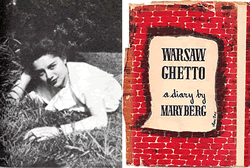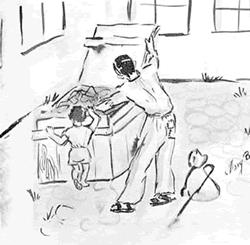Holocaust Diarist’s Photos Found at Estate Sale
Vast photo collection chronicling Mary Berg’s life discovered at local auction
By Sara Ivry

(Mary Berg)
“I’m calling about photos of Mary Berg,” said the man on my voicemail at work earlier this week. He wanted to know where he might send them for safekeeping.
The name Mary Berg was vaguely familiar to me. Several years ago Nextbook.org, Tablet’s predecessor site, published an essay by Amy Rosenberg about Warsaw Ghetto, a war memoir Berg had published in 1944, the year she had arrived as a young woman in the United States. Though Berg had spent two years in the Warsaw Ghetto, having fled there from Lodz, her mother was an American, a critical fact that entitled Berg, her sister and her parents to be included in a prisoner of war exchange program that saved their lives.
By the time they had arrived in New York, Berg had filled 12 volumes of a diary with vivid, brutal detail of what she witnessed during the years of German occupied Poland. These volumes became Warsaw Ghetto, which was well received in the New Yorker, the New York Times and other publications, and which briefly made Berg a minor celebrity.
In spite of the book’s critical success, it went out of print by the 1950s and, according to Rosenberg, Mary Berg tried hard to disappear along with it. She wanted nothing to do with a 2006 reissue of the memoir, and wrote Susan Pentlin, the retired University of Central Missouri professor who oversaw the diary’s republication (and who died this past December), that “instead of continuing to milk the Jewish Holocaust to its limits…do go and make a difference in all those Holocausts taking place right now in Bosnia or Chechin.”
Pentlin told Rosenberg in 2008 that Berg denied being Mary Berg more than once, and would not say if she knew what had become of Berg.
Then, last weekend, Glen Coghill, a 39-year-old Subway manager in York, Pennsylvania, west of Lancaster, went to an estate sale in the small nearby borough of Red Lion. Coghill started frequenting estate sales and auctions about 10 years ago, when he realized that the toys he played with as a child could earn him a lot of money on eBay. Now, he goes to five or six sales and auctions each week, buying goods well beyond Star Wars action figures.
A fan of military collectibles, Coghill was intrigued by a handful of photos of World War II fighter planes at last weekend’s sale. He bid on the trove of photo albums that included the plane pictures and a scrapbook that accompanied them, paying a mere $10 for the lot. At home later that day, he was examining the fighter pictures when he saw a telegram inviting a woman named Mary Berg to New York to talk. Based on photos of a woman in the album, he thought this Berg character was a model, and took to Google to find out more.
That’s when Coghill found Rosenberg’s essay, and realized whom that woman was he had seen from time to time around town.
“When I realized what it was—it was a little breathtaking, a little shocking,” Coghill said. He estimates there are about 300 pictures in the collection, chronicling Berg’s early life in Poland in the 1920s and through the 1950s, when she stepped away from the limelight.
“From what I can tell, there’s not much out there of her in pictures and to have this collection of her life… To see her in a photo holding a newspaper saying ‘Germany Surrenders,’ that’s kind of iconic,” he said.
The estate sale was not listed under the name Mary Berg. Coghill thinks the estate might have used a married name, but Rosenberg’s piece does not indicate if Berg ever married, and various online biographies say nothing of a spouse. Though Coghill could find no obituary, he thinks Berg may have died within the past six months.
Meantime, as Rosenberg makes clear, Berg did not want to be memorialized for what she experienced. She wanted to recede into history. Unlike the stories of Anne Frank or Elie Wiesel, “Mary Berg’s diary offers neither catharsis nor satisfaction,” Rosenberg wrote eloquently. “The story that comes after it is not tragic or triumphant; there is, in fact, no story. A terrible, true event took place, and someone lived to tell about it, and the world responded either indifferently or with misguided sympathy, and many hundreds of thousands more died despite the truths that had been told. After that there was nothing left to say.”
Given that, what should become of Berg’s photos and news clippings about her life and book? Should they too recede? It seems somehow shameful to discard the remnants of anyone’s life. Yet in Berg’s case, perhaps she wanted them discarded. Otherwise, she would have made arrangements to ensure their safekeeping.
For his part, Coghill wants to ferry them someplace safe. “I’d like to find a good home where they’ll be appreciated, where it’ll be a museum or a private collector,” he said. “I just want it to be like ‘Here’s Mary Berg’s history.’”
................................
-
Mary Berg, born and raised in Poland, was nineteen in March 1944, when she stepped off a prisoner-of-war exchange ship from Lisbon and onto a dock in New York. She stood with her American-born mother, her Polish father, and her younger sister, clutching a suitcase that contained her U.S. passport (thanks to her mother’s citizenship) and a set of twelve diaries describing her experiences in the Warsaw Ghetto. Before she cleared immigration, she met Samuel L. Shneiderman, a journalist who had come from Poland a few years earlier. Thirty-seven at the time, Shneiderman had worked as a reporter in Warsaw, become the Paris correspondent for a few Polish dailies, and covered the Spanish Civil War until he left Europe in 1940. In New York, he made it his mission to spread the news of Poland’s pain, and in particular the pain of its Jews. It’s not known quite how he and Berg met on the dock after her ship anchored; it seems he was milling about, seeking stories, and she captured his attention. (Judging from pictures, she cut a striking figure, tall and sturdy, with dramatic dark looks and gigantic eyes.) However it happened, he learned about her journals and convinced her to let him edit them.
The two worked together closely, Berg growing close to the journalist’s family as she spent weeks turning her Polish shorthand into actual narrative at Shneiderman’s kitchen table, his wife and two children looking on. After advising her about clarifications and additions he thought she should make, Shneiderman translated the narrative into Yiddish, and two months later, not long before D-Day, an excerpt appeared as the first in a series of ten monthly installments in one of New York’s leading Yiddish newspapers, the politically and religiously conservative Der morgen Zshurnal.
The grim facts Berg described are familiar to us now—all too familiar; we can easily fail to register their horror—but American readers in 1944 did not know them. A few other articles and pamphlets offering eyewitness testimonies emerged around the same time, but none did what Berg’s did: chronicled day-to-day life in the ghetto from its initial days through to the eve of residents’ first armed resistance, more than two years later.
